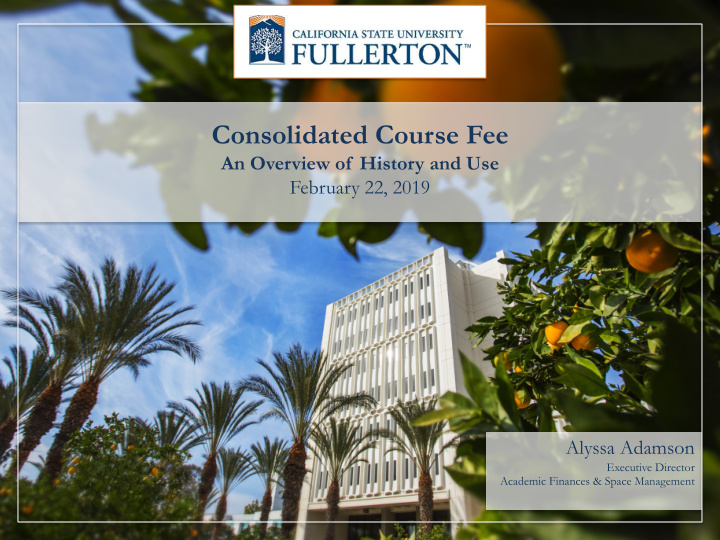



Consolidated Course Fee An Overview of History and Use February 22, 2019 Alyssa Adamson Executive Director Academic Finances & Space Management
Slide Title History Headcount fee • $9 1999 Established in 1999 to • consolidate many different $12 2003 individual course/material fees that were charged to students at that time $25 2009 As of 16-17 fee is adjusted • annually for inflation based on the Higher Education $25.45 2017 Price Index (HEPI)
Slide Title Approved Use of Funds Consolidated Course Fee revenues are used by the colleges to fund instructional supplies and services and other value added educational experiences not provided as part of the basic requirement for a course/lab. Examples: Software, equipment, maintenance, upgrades, and other materials.
Prohibited Purchases If an expense is associated with the basic course description, it is covered by the standard OE & E allocation funded by tuition fees. Examples of prohibited purchases: White boards, markers, copy paper, projector bulbs, basic chairs, desks, pointers, and podiums. Note: Salaries are prohibited except for individuals specifically hired to design or develop a value added instructional activity or to provide specialized training.
Slide Title Distribution of Funds Initial distribution of funds • based on course mix and documented need Monitored throughout the • year providing an opportunity for reallocation to colleges where there’s a need
Oversight Permitted uses reviewed annually at • department coordinator and college budget analyst training sessions Training is provided to all new • deans/department chairs/budget staff Balances are monitored throughout the year • “Is this eligible” questions are answered by • Provost’s Office Summary of expenses reported to the • Chancellor’s Office annually
Benefits 100% of funds are distributed to colleges and benefit students in the following way: Ensures access to leading-edge technologies for improved learning • opportunities Provides hands-on learning using software and equipment currently • used by corporations preparing students for the work force Ensures that all students have access to quality instruction without • being burdened with high materials and supplies fees Provides opportunities for more in-class demonstrations and projects •
Annual Receipts Term 2013-14 2014-15 2015-16 2016-17 2017-18 Fall $ 978,962 $ 966,888 $ 1,003,852 $ 1,031,755 $ 1,052,218 Intersession 42,375 42,266 47,409 53,800 54,153 Spring 920,521 949,607 981,574 1,010,245 1,020,986 Summer 220,707 210,493 231,689 222,653 226,083 Total $ 2,162,565 $ 2,169,254 $ 2,264,523 $ 2,318,454 $ 2,353,440
Summary of Use of Funds Category 2013-14 2014-15 2015-16 2016-17 2017-18 Events 0.40% 0.80% 0.97% 1.02% 1.24% Furniture 0.00% 0.73% 1.94% 2.42% 0.23% Instructional Support 1.64% 3.44% 4.58% 3.44% 3.34% Materials/Supplies 47.03% 36.30% 35.45% 31.50% 38.15% Misc 0.21% 0.48% 0.47% 0.55% 0.16% Repairs/Maintenance 1.79% 0.06% 2.90% 2.16% 1.44% Subscriptions 9.49% 10.21% 5.05% 4.23% 1.58% Technology 37.79% 46.70% 45.28% 52.27% 50.43% Travel 1.65% 1.28% 3.35% 2.40% 3.42% Grand Total 100.00% 100.00% 100.00% 100.00% 100.00%
MCF Funded Activities 1968 Mexico City Summer Olympics, gold medal winner Tommie Smith talks to students at CSUF about the continuing fight for civil rights. Smith was keynote speaker for a debate tournament awards ceremony. College of Communications
MCF Funded Activities Support for specialized equipment lab equipment: A colorimeter is a device used to test the concentration of a solution by measuring its absorbance of a specific wavelength of light. College of Natural Sciences and Mathematics
MCF Funded Activities Hands-on learning in a biomechanics lab College of Human Health & Development
Questions?
Recommend
More recommend